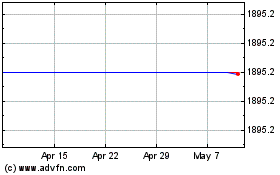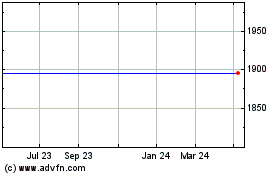Coronavirus Further Complicates Shell's Giant Floating Gas Project
August 22 2020 - 5:59AM
Dow Jones News
By Sarah McFarlane
Royal Dutch Shell PLC spent billions of dollars developing one
of the world's most challenging energy projects, a floating gas
terminal five football fields long. The coronavirus pandemic is
posing a new problem: How to get workers to safely start it back
up.
After years of delays, cost overruns, technical problems and
safety concerns, Shell began exporting natural gas from the
enormous vessel, known as Prelude, last year off the coast of
Australia. But production was halted in February because of an
electrical fault. Efforts to restart are now being slowed by
social-distancing requirements, the company said.
The work "continues to be impacted by measures in place to
reduce the risk of Covid-19 spread offshore," Shell said in an
emailed statement. It declined to say when Prelude would resume
exporting gas.
Prelude's plight highlights how the coronavirus has complicated
operations at some of the world's largest energy projects. Work
camps and oil-and-gas platforms in remote locations where staff
live in close quarters are vulnerable to the spread of the virus,
and there have been outbreaks this year at facilities in
Kazakhstan, Mozambique and offshore in the Gulf of Mexico.
It also illustrates how the destruction in energy demand caused
by coronavirus lockdowns, and resulting lower prices, is
challenging the economics of megaprojects that companies approved
when oil and gas prices were higher.
The largest facility of its kind ever built, Prelude was
supposed to be the first of several megavessels Shell planned in an
effort to tap hard-to-reach gas deposits out at sea. But the
company quickly decided Prelude would be a one-off as costs
escalated, according to a person who worked on the project.
Construction wound up costing $15 billion, a person familiar with
the matter said.
Some analysts estimate the overall costs were higher. Consulting
firm Wood Mackenzie pegged the likely cost at $17 billion, which it
estimates is around $5 billion more than Shell had initially
budgeted in 2011 when it was approved.
"When Shell sanctioned Prelude the oil price was above $100 a
barrel; the world was very different," said Daniel Toleman, an
analyst at Wood Mackenzie, adding that the shale boom and 2014
oil-price crash changed companies' thirst for new oil and gas
projects. Benchmark Brent crude traded at around $44 a barrel on
Friday.
Last month, Shell reduced the value of its assets by $16.8
billion after tax, part of a wave of write-downs in the energy
sector triggered by the current economic downturn. It didn't give a
breakdown of projects affected, but about $4 billion was attributed
to Prelude, said the person familiar with the matter.
The giant floating facility, 488 meters (about 1,601 feet) long
and able to accommodate 300 workers, can park directly above a gas
field and process its output into liquefied natural gas that can
then be transferred to other vessels and shipped around the world.
Traditionally, gas had to be piped under the ocean to a processing
facility onshore, which made tapping some remote fields too
costly.
Prelude is capable of supplying enough liquefied natural gas to
meet about half of Washington state's annual natural-gas demand. It
was particularly complex to construct because it was built to
operate in deep and sometimes rough seas, and processes gas into
three products: liquefied natural gas, liquefied petroleum gas and
natural-gas condensate.
"They went with this very large, very complex, not off-the-shelf
technology; they developed it as a bespoke project, and I guess
we'll know over the next 20 years, was that a successful decision?"
said Jason Feer, head of business intelligence at consulting firm
Poten & Partners Inc.
Major energy companies have made big bets on natural gas, but
its role in the energy mix is in flux as more countries make a
transition to low-carbon sources. Some environmental groups are
lobbying for a wholesale shift from all fossil fuels, which could
affect the economic viability of remote gas projects such as the
one Shell financed near Australia.
Shell says that while the virus has hit demand for natural gas,
it still believes the fundamentals of liquefied natural gas, or
LNG, remain strong. It says demand for LNG grew by 12.5% to 359
million metric tons in 2019 and that it expects long-term LNG
demand to grow by about 4% a year.
"Where we said in the past we will have stronger growth in LNG
than in any aspect of the carbon-based energy system, I still
believe that is the case," Shell Chief Executive Ben van Beurden
said on the company's earnings call in July.
Still, given this year's fall in global demand, analysts say
Shell would likely have needed to cut some of its production from
facilities such as Prelude in the short term anyway, lessening the
impact of its current problems.
"This has been an enforced cut back of production for them which
undoubtedly they are not happy about, but there is a silver
lining," said Mr. Feer.
Write to Sarah McFarlane at sarah.mcfarlane@wsj.com
(END) Dow Jones Newswires
August 22, 2020 05:44 ET (09:44 GMT)
Copyright (c) 2020 Dow Jones & Company, Inc.
Shell (LSE:RDSA)
Historical Stock Chart
From Mar 2024 to Apr 2024

Shell (LSE:RDSA)
Historical Stock Chart
From Apr 2023 to Apr 2024
